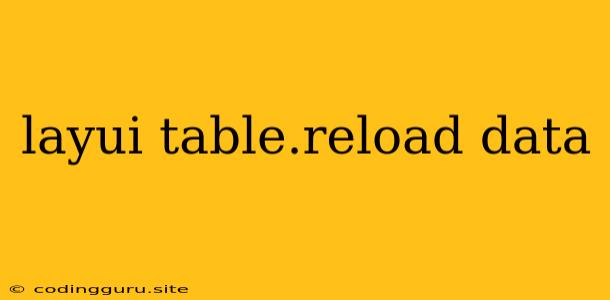Dynamically Updating Your Tables with Layui's table.reload
Layui, a popular front-end framework for building beautiful and user-friendly web interfaces, provides a powerful and versatile table component that simplifies data presentation and manipulation. One of the key features of Layui's table component is the table.reload method, which allows you to dynamically update the table content with fresh data without having to reload the entire page. This dynamic reloading feature is essential for creating interactive and responsive applications where data changes frequently.
Why Use table.reload?
Imagine building a web application that displays a list of users. You want the user list to be up-to-date as soon as a new user is added or an existing user is modified. With table.reload, you can refresh the table content without having to reload the entire page, resulting in a seamless user experience.
Here are some key benefits of using table.reload:
- Improved Performance: Reloading the entire page can be time-consuming and disrupt the user's workflow.
table.reloadonly reloads the necessary data, making it significantly faster. - Enhanced User Experience: Dynamically updating the table content provides a more engaging and responsive experience for the user.
- Reduced Server Load: By only fetching the updated data,
table.reloadminimizes the amount of data transferred between the client and server, reducing server load.
Understanding table.reload
The table.reload method is a versatile tool that offers several options for updating your table. Let's break down its core functionality:
Basic Usage:
layui.use('table', function(){
var table = layui.table;
// Assuming you have a table with id 'userTable'
table.reload('userTable', {
// Pass any data you want to reload here
data: newUserData
});
});
In this example, the table.reload method is called with the table's ID (userTable) and an object containing the new data (newUserData). Layui will intelligently replace the existing table data with the new data, providing a smooth transition for the user.
Customization Options:
table.reload offers numerous customization options to control how the table is updated. Here are some key options:
data: This parameter allows you to specify the new data to be used for the table. This can be an array of objects, or even a function that returns an array of objects.where: This parameter can be used to dynamically filter the data that is being reloaded.page: This parameter allows you to control which page of the table is being reloaded. For example, you could reload only the current page or jump to a specific page.initSort: You can specify the initial sorting condition for the table after the data reload.
Example: Reloading a Table After Adding a New Item
Let's say you have a table displaying a list of products, and a user can add new products. When a new product is added, you can use table.reload to update the table dynamically:
layui.use('table', function(){
var table = layui.table;
// Add a new product to the existing data
function addNewProduct(productName, price) {
var newProduct = {
name: productName,
price: price
};
// Update the table data
table.reload('productTable', {
data: function () {
// Get the current table data
var existingData = table.cache['productTable'];
// Add the new product
existingData.push(newProduct);
// Return the updated data
return existingData;
}
});
}
// Simulating adding a new product
addNewProduct('New Product', 100);
});
In this example, the addNewProduct function simulates adding a new product to the table data. It uses table.cache to access the current table data, adds the new product to the array, and then calls table.reload to update the table with the modified data.
Key Points to Remember
- ID and Data: Make sure to pass the correct table ID and the new data to the
table.reloadmethod. - Data Structure: The data you pass to
table.reloadmust match the structure of your table columns. - Caching: If you are using
table.cacheto access the current table data, make sure to update the cache correctly before callingtable.reload. - Performance: Avoid unnecessary data reloads. Only update the table when absolutely necessary to ensure optimal performance.
Conclusion
Layui's table.reload method is an indispensable tool for creating interactive and responsive web applications that display dynamic data. By leveraging table.reload's flexibility and customization options, you can easily keep your tables up-to-date with the latest information without the need for full page refreshes, resulting in a smoother and more enjoyable user experience.
